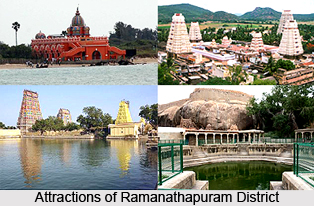 History of Ramanathapuram district bears the evidence of the rule of the Pandyas, Cholas, Marathas and also the British. In the beginning of the fifteenth century the present dominions of the district of Ramanathapuram comprising of Tiruvadanai, Paramakudi, Ramanathapuram, Kamuthi, Mudukulathur and Rameswaram taluks were included in Pandyan Kingdom. It remained for a short period under the rule of the Chola Kings when Rajendra Chola brought Ramanathapuram under his territory in A.D. 1063. In A.D. 1520, the Nayaks of Vijayanagar brought this area under their control from the Pandyan dynasty. For about two centuries, Marava chieftains-Sethupathis who were Lords under Pandyan Kings reigned over this part.
History of Ramanathapuram district bears the evidence of the rule of the Pandyas, Cholas, Marathas and also the British. In the beginning of the fifteenth century the present dominions of the district of Ramanathapuram comprising of Tiruvadanai, Paramakudi, Ramanathapuram, Kamuthi, Mudukulathur and Rameswaram taluks were included in Pandyan Kingdom. It remained for a short period under the rule of the Chola Kings when Rajendra Chola brought Ramanathapuram under his territory in A.D. 1063. In A.D. 1520, the Nayaks of Vijayanagar brought this area under their control from the Pandyan dynasty. For about two centuries, Marava chieftains-Sethupathis who were Lords under Pandyan Kings reigned over this part.
The earlier parts of the eighteenth century witnessed several disputes in the family of the rulers over succession which led to the division of Ramanathapuram. By the aid of the King of Thanjavur in A.D. 1730, one of the chieftains deposed Sethupathy and became the Raja of Sivaganga. Acting upon the weakness of the Nayak rules, the local chieftains became independent. Chand, a Sahib of Carnatic, captured Ramanathapuram and in 1741, the area came under the control of the Marathas and then under the Nizam in 1744 AD. The rule of the Nawabs made displeasure in the mind of those chieftains and thus they declared the last Nayak as ruler of Pandya Mandalam against the Nawab in 1752 AD. By that time, throne of Carnatic had two rivals, Mohamed Ali and Shanda Sahib, and this district was part of Carnatic. The French and the British supported Mohamed Ali and Chanda Sahib respectively and thus resulted in a series of conflicts in the southern part of the continent.
In the year 1795, the British East India Company deposed Muthuramalinga Sethupathy and took over the control of administration of Ramanathapuram. In the year 1801 Mangaleswari Nachiyar was made the Zamindar of Sivagangai. After passing of Queen, the Marudhu Brothers took the charge by paying regular revenue to the East India Company. In the year 1803, the Marudhu Brothers of Sivaganga revolted against the British along with Panchalamkurichi and Kattabomman. Colonel Agnew captured Marudhu Brothers and hanged them and then made Gowri Vallbah Periya Udaya Thevar as Zamindar of Sivaganga. After the defeat of Tipu Sultan, the British took the control of this district and imprisoned the Nawab. In the year 1892, the Zamindari system was abolished and for the administration of the district a British Collector was appointed.
Ramanathapuram was formed in the year 1910 by clubbing some portions of the Madurai district and Tirunelveli district. Shri J.F. Bryant (I.C.S) was the first collector of this district and the district was named Ramanathapuram. During the rule of the district, this district was called `Ramnad`. This name continued after the independence of India and later the district was renamed as Ramanathapuram. The district of Ramanathapuram was trifurcated on the 15th of March 1985. Pasumpon Muthuramalinga Thevar district was formed after the trifurcation of Ramanathapuram district and it consists of Karaikudi, Devakottai, Thiruppattur, Manamadurai, Ilaiyankudi and Sivaganga taluks. Later, this district was renamed as Sivaganga district. Another district which was formed is the Kamarajar District. This district consists of Virudhunagar, Sriviliputtur, Chiruchuli, Sattur, Aruppukottai and Rajapalayam taluks and later the district was renamed as Virudhunagar district. The district of Ramanathapuram consisted of the Paramakudi, Kamuthi, Tiruvadanai, Ramanathapuram, Mudukulathur and Rameswaram taluks. During the trifurcation of the Ramanathapuram district the district collector was Shri S.Gurumurthy (I.A.S).






